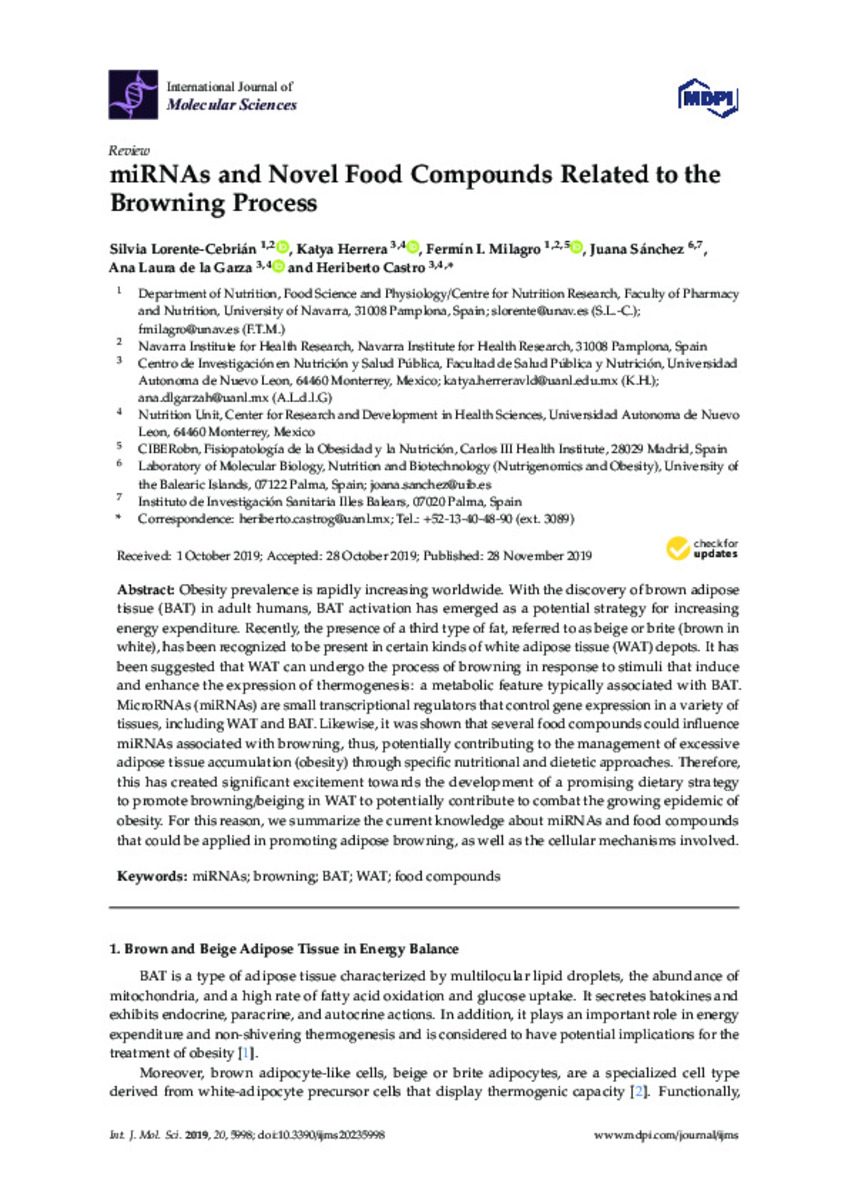Full metadata record
| DC Field | Value | Language |
|---|---|---|
| dc.creator | Lorente-Cebrian, S. (Silvia) | - |
| dc.creator | Herrera, K. (Katya) | - |
| dc.creator | Milagro-Yoldi, F.I. (Fermín Ignacio) | - |
| dc.creator | Sánchez, J. (Juana) | - |
| dc.creator | Garza, A.L. (Ana Laura) de la | - |
| dc.creator | Castro, H. (Heriberto) | - |
| dc.date.accessioned | 2021-11-02T09:08:05Z | - |
| dc.date.available | 2021-11-02T09:08:05Z | - |
| dc.date.issued | 2019 | - |
| dc.identifier.citation | Lorente-Cebrian, S. (Silvia); Herrera, K. (Katya); Milagro-Yoldi, F.I. (Fermín Ignacio); et al. "miRNAs and novel food compounds related to the browning process". International Journal of Molecular Sciences. 20 (23), 2019, 5998 | es_ES |
| dc.identifier.issn | 1422-0067 | - |
| dc.identifier.uri | https://hdl.handle.net/10171/62301 | - |
| dc.description.abstract | Obesity prevalence is rapidly increasing worldwide. With the discovery of brown adipose tissue (BAT) in adult humans, BAT activation has emerged as a potential strategy for increasing energy expenditure. Recently, the presence of a third type of fat, referred to as beige or brite (brown in white), has been recognized to be present in certain kinds of white adipose tissue (WAT) depots. It has been suggested that WAT can undergo the process of browning in response to stimuli that induce and enhance the expression of thermogenesis: a metabolic feature typically associated with BAT. MicroRNAs (miRNAs) are small transcriptional regulators that control gene expression in a variety of tissues, including WAT and BAT. Likewise, it was shown that several food compounds could influence miRNAs associated with browning, thus, potentially contributing to the management of excessive adipose tissue accumulation (obesity) through specific nutritional and dietetic approaches. Therefore, this has created significant excitement towards the development of a promising dietary strategy to promote browning/beiging in WAT to potentially contribute to combat the growing epidemic of obesity. For this reason, we summarize the current knowledge about miRNAs and food compounds that could be applied in promoting adipose browning, as well as the cellular mechanisms involved. | es_ES |
| dc.description.sponsorship | This research was funded by the Programa de apoyo a la publicación científica en revistas indexadas en el Journal Citation Report de la Universidad Autónoma de Nuevo León and was granted to A.L.G. and H.C. | es_ES |
| dc.language.iso | eng | es_ES |
| dc.publisher | MDPI AG | es_ES |
| dc.rights | info:eu-repo/semantics/openAccess | es_ES |
| dc.subject | miRNAs | es_ES |
| dc.subject | Browning | es_ES |
| dc.subject | BAT | es_ES |
| dc.subject | WAT | es_ES |
| dc.subject | Food compounds | es_ES |
| dc.title | miRNAs and novel food compounds related to the browning process | es_ES |
| dc.type | info:eu-repo/semantics/article | es_ES |
| dc.description.note | This is an open access article distributed under the Creative Commons Attribution License which permits unrestricted use, distribution, and reproduction in any medium, provided the original work is properly cited. | es_ES |
| dc.identifier.doi | 10.3390/ijms20235998 | - |
| dadun.citation.number | 23 | es_ES |
| dadun.citation.publicationName | International Journal of Molecular Sciences | es_ES |
| dadun.citation.startingPage | 5998 | es_ES |
| dadun.citation.volume | 20 | es_ES |
Files in This Item:
Statistics and impact
Items in Dadun are protected by copyright, with all rights reserved, unless otherwise indicated.






